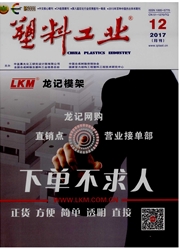

 中文摘要:
中文摘要:
为了考察醋酸酯淀粉薄膜在不同环境中的降解特性,将醋酸酯淀粉薄膜分别置于pH=1.2、7、12的模拟环境中一定时间进行降解,利用扫描电子显微镜(SEM)、X射线衍射仪(XRD)、接触角测量仪、材料试验机、动态热机械分析仪(DMA)对不同浸泡时间的薄膜失重率、表面形貌、结晶结构、疏水性能及力学性能等进行了表征和分析。结果表明:不同pH环境对醋酸酯淀粉薄膜结晶结构及降解性能均有一定程度的影响。在降解过程中薄膜仍然保持V型结晶结构,疏水性能和断裂伸长率显著下降,拉伸强度呈先上升后下降的趋势。碱性环境中,薄膜在前14d的降解速率最大,表面出现局部孔洞,结晶度呈逐渐升高的趋势;酸性环境中,降解后期降解程度较大,表面有明显缺陷,结晶度在降解前期上升,28d后开始下降。研究结果为研制和开发不同降解时间要求和应用环境的淀粉基生物降解材料提供了基础数据。
 英文摘要:
英文摘要:
In order to investigate the degradation property of acetylated starch film in simulated environments with different pH, acetylated starch film was installed in the different simulated environments with different pH as 1.2, 7, 12, respectively. The weight loss rate, surface morphology, crystalline structure, hydrophobie property and mechanical property were characterized and analyzed by SEM, XRD, contact angle measurement, mechanical testing and DMA. The results showed that the structure and mechanical L property of acetylated starch film were affected by the different values of pH. During the degradation, the V-type crystalline structure of the film was kept and the hydrophobic property and elongation at break decreased while the tensile strength decreased after an initial increase. Under the alkaline condition, the degradation rate of the film was much higher in the initial 14 days and the surface defect was partially appeared and the erystallinity increased as the degradation time increased. In contrast, under the acid condition, the film degradated more quickly in later stage and the holes were appeared on the surface of the film and the crystallinity increased before decreasing from the 28th day. These results provided fundamental data for the development of the starch-based degradable materials with different degradation rate which were suitable for different application environment.
 同期刊论文项目
同期刊论文项目
 同项目期刊论文
同项目期刊论文
 Multi-scale structural and digestion resistibility changes of high-amylose corn starch after hydroth
Multi-scale structural and digestion resistibility changes of high-amylose corn starch after hydroth Effect of oxygen glow plasma on supramolecular and molecular structures of starch and related mechan
Effect of oxygen glow plasma on supramolecular and molecular structures of starch and related mechan Preparation and characterisation of octenyl succinate starch as a delivery carrier for bioactive foo
Preparation and characterisation of octenyl succinate starch as a delivery carrier for bioactive foo An oral colon-targeting controlled release system based on resistant starch acetate: Synthetization,
An oral colon-targeting controlled release system based on resistant starch acetate: Synthetization, 期刊信息
期刊信息
